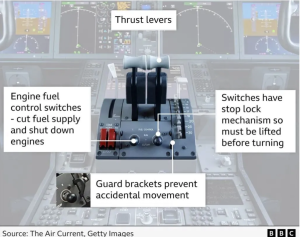A preliminary report from India’s Aircraft Accident Investigation Bureau (AAIB) suggests that the June 12 crash of the Boeing 787 being operated as Air India Flight 171 happened because seconds after lift-off, both engine fuel-control switches inexplicably moved from “RUN” to “CUTOFF,” instantly shutting down fuel to both engines. Although the pilots managed to reset the switches and re-start the engines, the action was too late and the aircraft crashed into a medical college hostel in Ahmedabad, tragically killing 241 people on board and 19 others on the ground.
The unanswered question as of now, however, is whether the switches were moved intentionally or inadvertently. Either way, the action would have to have been taken twice in very short order. That fact simply deepens the mystery. The picture below, taken from a very recent BBC article about the crash, shows the two switches in question. Sitting side by side, just below the Thrust Levers, the two small, round switches must ordinarily be pulled straight up or out before being moved down to the cutoff setting.

The issue raised is whether there was a defect in both switches that allowed them to be accidentally bumped into the fuel cutoff position without first having been pulled up. That scenario certainly seems unlikely, but stranger things have happened. The dual and simultaneous defect theory is one that is being investigated further by Indian officials, Air India and representatives of Boeing and the U.S. government.
If the two movements were intentional and there was no defect, several entirely new sets of issues arise, including pilot training, pilot skills, cockpit coordination, and even crewmember mental health.
While the transcript of the crew’s discussions has not yet been released, the AAIB preliminary report states that one of the pilots (it is unknown which) asked the other why he cut off the fuel. The other apparently responded that he didn’t. Again, the mystery deepens.
Echoes of Past Crashes
In some ways, this scenario bears similarities to the 2018 East River helicopter crash, where the aircraft’s fuel shutoff lever was tripped when a passenger tether interfered with the switch, shutting down the engine and causing the helicopter to descend into the water. In other ways, this incident raises questions similar to those still being asked regarding the crash of Malaysia Airlines Flight 370, where a Boeing 777 aircraft dramatically departed it’s flight path and presumably crashed into the Southern Ocean, raising questions of pilot mental health.
It is far too soon to know what caused the Air India Flight 171 crash. Many following the story closely have complained that the Indian government is not being transparent and is perhaps working in some respect with the aircraft manufacturer to simply blame the pilots. If pilot error is blame, then the airline and the Indian officials should work quickly and diligently to correct any issues on that end. If a defect exists, however, Boeing and the U.S. government should take the same measures to ensure that there is not a larger problem and that such a crash never happens again.
Angelley Hightower PLLC is a nationally recognized aviation accident law firm representing victims and families in commercial, general and military aviation crash cases.